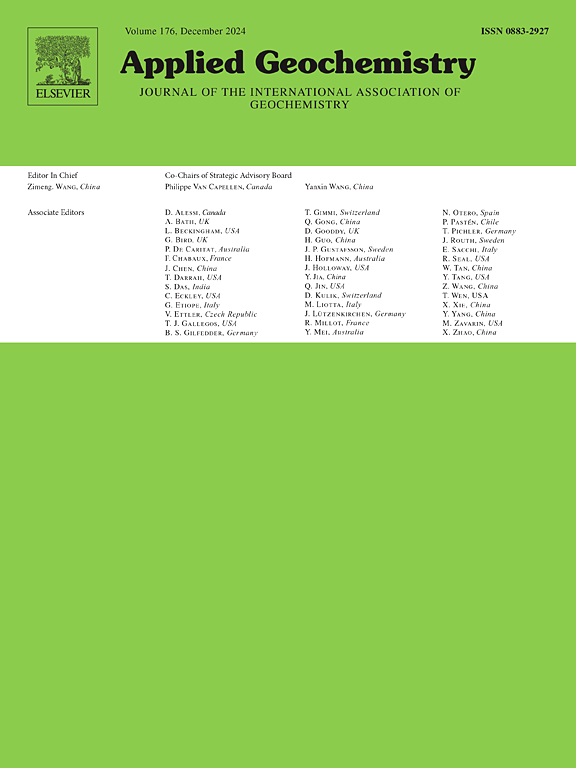Deposition and early diagenesis of terrestrial plant-derived terpenoids in deep-sea sediments in the northwestern Pacific ocean off Japan
IF 3.4
3区 地球科学
Q1 GEOCHEMISTRY & GEOPHYSICS
引用次数: 0
Abstract
Terrestrial plant-derived terpenoids (TPTs) in deep-sea surface to subsurface sediments of the northwestern Pacific were investigated at two sites along the Kuroshio Current and in the gyre over the Nishishichitou Ridge following a latitudinal transect at 138°36′E (Sites LM3 and LM5P), as well as the Japan Trench off the Sanriku coast of northeastern Japan (Site LM8). Cadalene, oleanene, and retene were detected as geoterpenoids in all cores. Possible sources of these geoterpenoids are soil materials, which were attached to clay minerals with or without early diagenetic alteration of precursor bioterpenoids. Friedelin and dehydroabietic acid (DAA) were identified as major functionalized TPTs, or bioterpenoids, in all core samples. Concentrations of TPTs in the core-top samples from all study sites varied with distance from land, sediment lithology, and upland vegetation. Bioterpenoids in the TPTs are relatively abundant at all sites. These results suggest that TPT biomarkers are mainly transported to the open ocean as bioterpenoids. The ratio of friedelin to DAA in core-top samples clearly varied (2.53 in LM3, 1.12 in LM5P, and 0.95 in LM8) depending on upland vegetation, and therefore the bioterpenoid ratio is proposed to be a (paleo)vegetation indicator. Vertical profiles of TPT concentrations showed pronounced variability. The concentrations of oleanene and retene generally decreased with depth in all cores, indicating that these compounds are labile in surface to subsurface sediments. However, the cadalene concentration increased or decreased slightly with depth in cores from the Nishishichitou Ridge, indicating that cadalene is a refractory compound. The DAA concentration decreased markedly with depth, and the gradients were similar in all cores. Thus, DAA was effectively decomposed and behaved as a typical labile compound. On the other hand, the friedelin concentration increased slightly with depth in the core collected off the Sanriku coast. Thus, friedelin appeared to behave as a refractory compound in surface to subsurface sediments despite being a bioterpenoid.
日本西北太平洋深海沉积物中陆生植物萜类化合物的沉积和早期成岩作用
研究了西北太平洋深海表层至次表层沉积物中陆生植物衍生萜类化合物(TPTs)的分布,地点为黑潮海流和西头海岭上沿纬向138°36′e的环流(LM3和LM5P),以及日本东北部三陆海岸外的日本海沟(LM8)。在所有岩心中均检测到地土萜类化合物,包括Cadalene、齐墩烯和retene。土萜类化合物的可能来源是附着在粘土矿物上的土壤物质,有或没有前体生物萜类物质的早期成岩蚀变。在所有的岩心样品中,弗里德林和脱氢枞酸(DAA)被鉴定为主要的功能化tpt或生物萜类化合物。所有研究地点的岩心顶部样品中TPTs的浓度随与陆地、沉积物岩性和高地植被的距离而变化。tpt中的生物萜类化合物在所有部位都相对丰富。这些结果表明,TPT生物标志物主要以生物萜类物质的形式转运到公海。岩心顶部样品中friedelin / DAA的比值(LM3为2.53,LM5P为1.12,LM8为0.95)因高原植被的不同而有明显的变化,因此提出生物萜类比值可以作为(古)植被指标。TPT浓度的垂直剖面表现出明显的变异性。齐墩烯和网烯的浓度随岩心深度的增加而降低,表明这些化合物在地表和地下沉积物中都是不稳定的。然而,在西石头脊的岩心中,钙二烯的浓度随岩心深度的增加而略有增加或减少,表明钙二烯是一种难熔化合物。DAA浓度随深度显著降低,且各岩心的梯度相似。因此,DAA被有效分解,表现为典型的不稳定化合物。另一方面,在三陆海岸收集的岩心中,随深度的增加,弗里德林浓度略有增加。因此,尽管弗里德林是一种生物萜类化合物,但它在地表到地下沉积物中表现为一种难降解化合物。
本文章由计算机程序翻译,如有差异,请以英文原文为准。
求助全文
约1分钟内获得全文
求助全文
来源期刊

Applied Geochemistry
地学-地球化学与地球物理
CiteScore
6.10
自引率
8.80%
发文量
272
审稿时长
65 days
期刊介绍:
Applied Geochemistry is an international journal devoted to publication of original research papers, rapid research communications and selected review papers in geochemistry and urban geochemistry which have some practical application to an aspect of human endeavour, such as the preservation of the environment, health, waste disposal and the search for resources. Papers on applications of inorganic, organic and isotope geochemistry and geochemical processes are therefore welcome provided they meet the main criterion. Spatial and temporal monitoring case studies are only of interest to our international readership if they present new ideas of broad application.
Topics covered include: (1) Environmental geochemistry (including natural and anthropogenic aspects, and protection and remediation strategies); (2) Hydrogeochemistry (surface and groundwater); (3) Medical (urban) geochemistry; (4) The search for energy resources (in particular unconventional oil and gas or emerging metal resources); (5) Energy exploitation (in particular geothermal energy and CCS); (6) Upgrading of energy and mineral resources where there is a direct geochemical application; and (7) Waste disposal, including nuclear waste disposal.
 求助内容:
求助内容: 应助结果提醒方式:
应助结果提醒方式:


